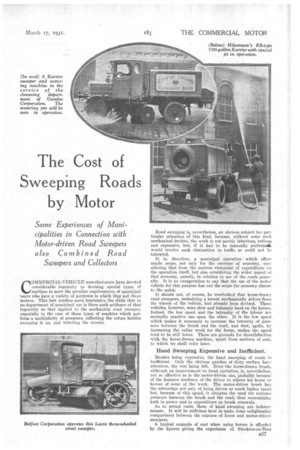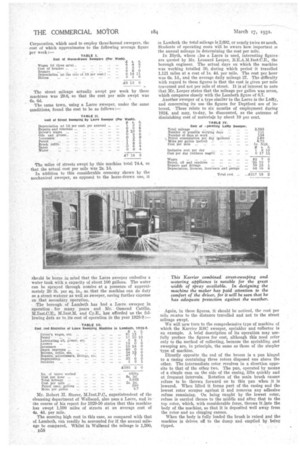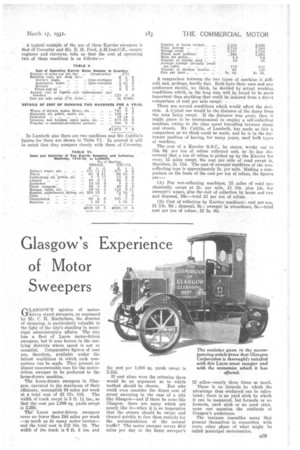The Cost of Sweeping Roads by Motor
Page 127

Page 128

Page 129

If you've noticed an error in this article please click here to report it so we can fix it.
Some Experiences of Municipalities in Connection with Motor-driven Road Sweepers also Combined Road Sweepers and Collectors
COMMERCIAL-VEHICLE manufacturers have devoted considerable ingenuity to devising special types of machine to meet the peculiar requirements of municipal users who have a variety of purposes to which they put those motors. This fact renders more impressive the claim that in no department of municipal use is there such evidence of that ingenuity as that applied to the mechanical road sweeper, especially in the case of those types of machine which perform a multiplicity of purposes, collecting the refuse besides sweeping it up, and watering the streets.
Road sweeping is, nevertheless, an obvious subject for particular attention of this kind, because, without some such mechanical devices, the work is not merely laborious, tedious and expensive, but, if it had to be manually performed, would involve such obstruction to traffic as could not be tolerated.
It is, therefore, a municipal operation which offers ample scope, not only for the exercise of economy, considering that from the narrow viewpoint of expenditure on the operation itself, but also considering the wider aspect ol that economy, namely, in relation to use of the roads generally. It is no exaggeration to say that the use of the motor vehicle for this purpose has cut the scope for economy almost to the quick.
It should not, of course, be overlooked that horse-drawn road sweepers, embodying a broom mechanically driven from the wheels of the vehicle, had already been devised. These vehicles, however, were slow and intensely hard on the horses. Indeed, the low speed and the intensity of the labour are mutually reactive one upon the other. It is the low speed which makes. it necessary to increase the intensity of pressure between the brush and the road, and that, again, by increasing the collar work for the horse, makes the speeul tend to be still lower. These are grounds for dissatisfaction with the horse-drawn machine, apart from matters of cost, to which we shall refer later.
Hand Sweeping Expensive and Inefficient.
Besides being expensive, the hand sweeping of roads is inefficient. Only the obvious patches of dirty surface have attention, the rest being left. Even the horse-drawn brush, although an improvement on hand operation, is, nevertheless, not so effective as is the motor-driven one, probably because of the humane tendency of the driver to relieve his horse or horses of some of the work. The motor-driven brush has the advantage not only of being driven at much higher speed but, because of this speed, it obviates the need for extreme pressure between the brush and the road; thus economizing both in power and in expenditure on brush renewals.
As to actual costs, those of hand sweeping are indeterminate. It will be sufficient here to Make some enlightening comparisons between the expense of horse and motor-driven swee.pers.
A typical example of cost when using horses is afforded by the figures giving the experience of Stockton-on-Tees D57
Corporation, which used to employ three-horsed sweepers, the cost of which approximates to the following average figure per week :—
The street mileage actually s wept per week by these machines was 29.6, so that the cost per mile swept was 6s. 6d.
The same town, using a Lacre sweeper, under the same conditions, found the cost to be as follows:— Should be borne in mind that the Lacre sweeper embodies a water tank with a capacity of about 100 gallons. The water can be sprayed through nozzles at a pressure of approximately. 20 lb. per sq. in., so. that the machine can do duty as a street waterer as well as sweeper, saving further expense on that secondary operation. , The borough .of Lambeth has had a .Lacre sweeper in eperation . for many years and . Mr. Osmond Cattlin, M.Inst.C.E., MInit..141. and C'y.E., has afforded us the following data as to its cost of operation in the year 1928-9 :--- Mr. Robert H. Storer, M.Inst.P.C., superintendent of the cleansing department of Wallsend, also uses a Lacre, and in the course of his report for 1929-30 states that this machine has swept 1,590 miles of streets at an average cost of 4s. 4d. per mile.
The seeming high cost in this case, as compared with that of Lambeth, cab readily be accounted for if the annual mileage be compared. Whilst in Wallsencl the mileage is 1,590, D58 in Lambeth the total mileage is 2,692, or nearly twice as much. Students of operating costs will be aware how important is the annual mileage in determining the cost per mile.
In Blyth, where 1.1so a Lacre is used, interesting figures. are quoted by Mr. Leonard Leeper, B.E.A.M.Inst.C.E., the borough engineer. The actual days on which the machine was working totalled 30, during which period it travelled 1,121 miles at a cost of is. 4d. per mile. The cost per hour was Gs, id., and the average daily mileage 37. The difficulty With regard to these figures is that the cost is given per mile traversed and not per mile of street. It is of interest to note that Mr. Leeper states that the mileage per gallon was seven, which compares closely with the Lambeth figure of 6.7.
Another sweeper of a type similar to the Lacre is the Laffiy, and concerning its use the figures for Deptford • are of interest. These relate to six months of employment during 1924, and may, to-day, be discounted, as the outcome of diminishing cost of materials by about 10 per cent.
Again, in these figures, it should be noticed, the cost per mile re,ates to the distance travelled and not to the street mileage swept.
We will now turn to the comprehensive type of machine of which the Karrier RSC sweeper, sprinkler and collector is an example. A brief description of its operation may usefully preface the figures for cost, although this need refer only to the method of collecting, because the sprinkling and sweeping are, in principle, the same as those of the simpler type of machine.
Directly opposite the end of the broom is a pan hinged to a casing containing three rotors disposed one above the other. The intermediate rotor revolves in a direction opposite to that of the other two. The pan, operated by means of a simple cam on the side of the casing, lifts quickly and at frequent intervals. Rotation of the main brush causes refuse to be thrown forward on to this pan when it is lowered. When lifted it forms part of the casing and the lowest rotor scrapes against it and removes any adhesive refuse remaining. On being caught by the lowest rotor, refuse is carried thence to the middle and after that to the top rotor, which, with considerable force, throws it,into the body of the machine, so that it is deposited well away from the rotor and no clogging ensues.
When the body is fully loaded the brush is raised and the machine is driven off to the dump and emptied by being tipped.
A typidal example of the use of these Karrier sweepers is that of Coventry and Mr. E. n. Ford, :A.M.Inst.C.E., county engineer and Surveyor, tells us that the cost of operating two of these machines is as follows:
In Lambeth also there are two machines and Mr. Catein's figures for these are shown in Table VI. In general it will be noted that they compare closely with those of Coventry. A comparison between the two types of machine is difficult and, perhaps, hardly fair. Both have their uses and any preference should, we think, be decided by actual working conditions which, in the long run, will be found to be more important than anything that could be deduced from a direct comparison of cost per mile swept.
There are several conditions which would affect the delision. A typical one would be the distance of the dump front the area being swept. If the distance was great, then it might prove to be uneconomical to employ a self-collecting machine, owing to the time spent travelling between dump and streets. Mr. Cattlin, of Lambeth, has made as fair a comparison as we think could be made, and he is in the fortunate position of having, for many years, used both types of machine.
The cost of a Karrier R.S.C., he states, works out to 33s. 9d. per ton of refuse collected and, as he. has discovered that a ton of refuse is picked up by the Karrier for every 15 miles swept, the cost per mile of road swept is, therefore, 2s. 11d. The cost of sweeper machines of the noncollecting type is approximately 2s. per mile. Making a comparison on the basis of the cost per ton of refuse, the figures are : (A) For non-collecting machines, 15 miles of 'road mechanically swept at 2s. per mile, £1 10s. plus 14s. for sweeper's wages, plus the cost of collection by horse and van and disposal, 16s.-total £3 per ton of refuse.
(B) Cost of collection by Karrier machines : cost per ton, £1.13s. 9d.; disposal, 6s. 9 • sweeper in attendance, PA.-total cost per ton of refuse, 12 5s. 9d.
























































































































































































